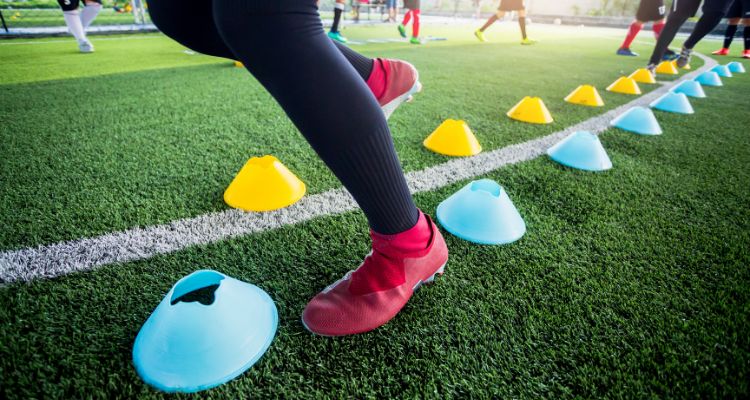
In this post, we will focus on strength training for footballers, a critical component of physical fitness that must be combined with other aspects such as power, speed, control, and endurance.
The degree of physical preparation of the players is increasing; therefore, training research and planning demand more physiological knowledge to aid the team in achieving the highest possible performance, both individually and collectively.
What are the benefits of strength-training circuits?
- Enhance overall performance.
- Increase overall physical fitness.
- Prevent injuries from occurring.
- Improve recovery after matches.
Strength Training for football
There are two sorts of strength to focus on in football: general and specific.
The first relates to increasing muscular contraction, resistance, and strength through fundamental workouts that prepare the body for specialized drills.
The second focused in various specific strength activity within the field and is divided into four sections of work: contact, jumping, hitting, and displacement.
Through a series of specific drills, we will be able to work both, depending on the type of strength we want to enhance.
Strength training exercises for football players
Let’s talk about about how to build strength using four different methods: displacement, contact, striking, and jumping.
- Displacement exercises
We can get all of the information about what happens on the field by using applications.We can monitor and track the player’s activities in both training and matches thanks to them.
When performing displacement exercises, it is critical to evaluate and assess the results of each player’s. Their pace, sprints, brakes, and slowdowns, among other things.
To work on it thoroughly, it should be divided into 4 subsections:
Eccentric overload
Eccentric force is used to regulate a movement, such as descending stairs or a hill, braking after a run, or leaping.
From a physiological standpoint, it refers to when a muscle lengthens while generating a force, causing the resistance to be substantially higher than the force created.
These exercises are highly suggested when arranging pre-season training for proper body adaption of the player.
The lower body is emphasized, with a focus on the core, trunk, glutes, knees, and calves. Here are some exercise examples:
- In a kneeling position on the floor, a partner holds our heels, and we let ourselves fall forward to practice gravity retention for a few seconds. It is important to keep the lower back straight to avoid injury.
- Squats with resistance bands or muscle straps in front of a ladder wall, with the bands behind the knees. Lower to 90 degrees and hold for 5 seconds, returning to the starting position straight.
- Open and close exits with a resistance band or pulley tied to our waist. Upon receiving this pull, the body will activate its eccentric force with the side leg that will change direction and with the opposite leg in the next exercise. It is advisable to introduce hip rotation exercises with this one.

Maximun Strenght
The ability of a collection of muscles, or one muscle in particular, to generate muscular force at a specified moment with a specific load is referred to as maximal strength.
Its outcomes are closely tied to power and speed, and they favor the player’s continuing training throughout the season, at the level of muscle adaptation and performance.
To minimize damage and get greater outcomes, it is advisable to raise the weight once the technique has been perfected during execution.
Without a doubt, the previous phase in the preparation of explosive strength workouts that will be shown in the following point.
The length of this strength training is shorter for professional football players than for novices.
- Back squats and front squats with the aid of weights to strengthen the back and chest, respectively.
- Lying femoral curl with weights and leg extension to strengthen the femoral
- Bulgarian squats.
- Dead weight with a barbell up to the waist.
- Ankle hold and core drop to the floor.
Explosive Strength
The goal of explosive strength is to determine performance and empower various muscle groups.
Technically, it refers to the capacity to move a person or a portion of the body that is sustaining a weight or resisting movement in the smallest amount of time and at a precise moment.
In football, there are two types of explosive strengths: those that are integrated into the game system and those that are decontextualized outside of it.
It is done on a regular basis, once or twice a week, with a high degree of intensity, with series (between 5 and 6) and 8 to 10 repetitions, with a 4 minute break in between.
We recommend the following exercises for strength training:
Squats with an end jump.Jumps with a step: up and down.Rotations in 90º position with extra load.Push-ups Lunges with a pulley.
Resistance Strength
It is the ability to maintain a constant effort for a prolonged period of time without fatigue.
It is directly proportional to the maximal strength as well as the duration and intensity of the effort at the time.
It is vital to combine work with a healthy food plan for maximum results. The technical crew and nutritionists will be in charge of determining what to consume prior to a game.
You might try the following exercises:
- Runs at high speeds with abrupt pauses.
- Running across obstacles while carrying a ball.
- Jumps and running starts can be done sideways, with stairs, with body extension, laying down, or with a squat start.
- Lateral displacements with and without balls and obstacles.

2. Contact strength exercises
These are the most common actions on the field, as they are those in which several players fight for the same goal, either:
- The ball.
- The position.
- Possession.
- The trajectory through tactics such as steals, tackles, and jumps, among others.
For maximum contact strength, it is vital to focus on all of the muscle components, particularly the torso and lower body.
Keeping in mind the need of developing the musculature of these two regions through high-intensity workouts.
3. Jumping training exercises
Jumps will account for a considerable part of the actions that will occur during the match, depending on the location held on the field.
Jumping may be seen during goals, saves, defense, kickoffs, and ball thefts.
How to improve your jumping?
It is not only necessary to be very tall but also to have a good technique for its execution, such as coordination, stability, visual perception, and, of course, muscular development, as we have been commenting throughout the article.
- This is a collection of strength training workouts for professional football players:
- Lower body.
- Falls and recoveries
- Proprioception: one-leg balance test, medicine ball pass, jumps with obstacles…

4. Shooting power exercises
Striking, as the name implies, is one of the most common actions employed throughout footballmatches, whether it be ball-keeping, passing, stealing, kicking, or shooting at goal.
What aspect do we need to work on?
- Coordination.
- Balance.
- Precision.
- Power.
This is accomplished by executing workouts that target specific parts of the body, such as the knee extensors, hip, adductors, and sacroiliac area.
- Core exercises: scoops, leg and gluteal lifts, crunches, and headstand extension…
- Lumbar strengthening exercises: pulleys, pull-ups, rowing, pull-overs.
- Lumbar extensions: alternating leg and arm lifts, full extension face down, dorsal-lumbar extension on all fours…
- Hamstring exercises: Russian skipping, pelvic lift, Nordic curl, dead weight, hip extension with knee flexion, isometric bridge…
- Lifting from the floor.
We would like to underline the need of taking extra care with the knee region, which is frequently mistreated during these activities.



